Investigative journalists offer selfless service in terms of promoting dissenting opinions and discourse in society. Sadly, people in power often resort to threatening their dignity, profession and lives. And it’s only getting worse.
Last week, a Saudi Arabian journalist named Jamal Khushoggi was allegedly murdered in the Saudi Consulate of Instanbul in Turkey. Turkish officials claimed to have audio and video evidence of the same which Saudi Arabia blatantly denied. This ploy on behalf of the government of Saudi Arabia has faced international backlash, with the White house condemning the attack and considering sanctions.
With a twitter following of more than 2 million, Khushoggi was an outspoken critic of Saudi governance and policies and a member of the nouveau elite among journalists and writers worldwide. From a self imposed exile in the United States of America, he contributed to editorials in BBC, Al Jazeera and the Washington Post. He is infamous among the conservative Arab elite for campaigning that Islamist movements such as the Muslim Brotherhood should be included in choices available to the region’s citizens. Saudi officials classify the Muslim Brotherhood as a terrorist group. Saudi Arabia is notorious for ‘eliminating’ all those it sees as a threat to its sovereignty. A well reputed journalist with a vast and infiltrating network of informants and sources, and an advocate for democratic governance in the Middle East, Khushoggi was without a doubt, a prime target.
On 13 June 2018, a leading newspaper journalist and editor in Indian-administered Kashmir, Shujaat Bukhari, was murdered by gunmen in Srinagar, India. Bukhari, a frequent contributor to the BBC News website, was attacked in his car near the office of the Rising Kashmir newspaper, which he founded and edited. He previously worked for The Hindu, and was well known for groundbreaking reports, unprecedented exposés, and strong views about the ideals of journalism.
In September 2017, Gauri Lankesh, a prominent Indian journalist critical of Hindu nationalist politics was shot dead in Karnataka.. The death of such a high profile journalist triggered protests in several Indian cities including Delhi. The news made top headlines in Indian media, with editors and journalists condemning her murder and paying tribute to her work.
In the same year, Zehra Dogan, a Kurdish artist and journalist, who was the founder and the editor of Jinha, a feminist Kurdish news agency was jailed by the Turkish government for a painting of the destruction of the city of Nusaybin in 2017. This also faced international backlash, although in vain.
These cases highlight the egregious nature of the increasing crimes against those working in the media. According to the BBC, more than 2,500 journalists have been killed since 1990, and media rights groups warn of a growing trend of journalists being targeted for the work they do. This occupational hazard ranges from physical harm and violence to rape threats and even conviction or imprisonment in certain autocratic states.
This has had a detrimental effect on reporting standards, since high profile kidnappings and beheadings of foreign journalists in 2012 onwards sparked a shift in news organisations’ policy, with fewer correspondents being sent into danger zones.
Most of those killed were murdered for their investigations into political corruption and organised crime, according to several media rights groups. Imprisonment has always been a form of intimidation. These practices are aimed towards silencing those in jail and intimidating those outside reporting it. Journalists have been targeted by security forces and militants alike. Publications have been denied federal government adverts—a key source of revenue for smaller newspapers.
In India, with nationalists trying to purge all manifestations of ‘anti-national’ thought from the national debate, self-censorship is growing in the mainstream media, primarily due to cases of violence against these ‘anti-national’ writers. Adding to that, radical ‘nationalist journalists’ have also targeted other writers, with online smear campaigns and threats of physical reprisals.
When Afzal Guru, a Kashmiri separatist convicted over the 2001 Indian parliament attack was hanged in 2013, copies of newspapers were seized from the press and the stands. Newspapers were forced to cease publication for approximately four days.
Since the outbreak of armed rebellion in Kashmir in early 1990, media in the region has had to work on a razor’s edge in what is effectively the world’s most heavily militarised zone. Authorities had forced several media platforms to suspend publication during the protests against Indian rule in 2008 and 2010 as well.
These instances compel us to think about the endangerment of freedom of speech and expression of media. Not only are these against the very foundation of democratic ideals, but also imperative to avoid negative flow of information, false propaganda, heavy state censorship, and asymmetric information. Media should not be seen as an enemy in a democratic set up. Stifling the media does not help to strengthen the democracy. The occupational hazard that comes complimentary with the status of ‘the people’s voice’ is far too detrimental and comes full circle when governments, state functioning, and economies implode, as history has proven time and again.
Feature Image Credits: CNN
Nikita Bhatia






